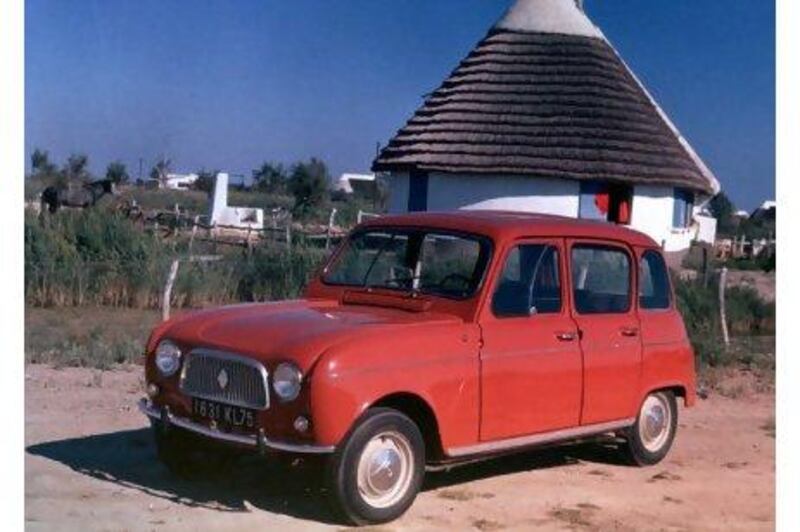Some cars are admired for their rarity, desired all the more because most mortals will never get to own or drive one. Then there are others that are so familiar that over decades of manufacturing they have been woven into the fabric of society. They become a part of the community, as commonplace as buses and bakeries, as reassuringly familiar as a postman on his morning round.
The Renault 4 was designed in the late 1950s as the everyman's car and, after more than eight million were made in a production run spanning from 1961 to 1994, it seemed that every man had bought one. Renault called its prototype for the car Project 350; this referred to the prime objective of making the car available for 350,000 francs ($50).
The designers had an obvious comparison in the iconic 2CV of French rival Citroën. Although the 2CV was already considered one of the most quintessentially French designs ever to hit the road, it did have its faults. It was very slow, ponderous unless on the straight and narrow, had limited load space and proved a little too dainty and delicate for rough French roads. Renault wanted the R4 to be durable and dependable. In Colombia, where it was made under licence, it was nicknamed Amigo Fiel, the faithful friend. It was so faithful that after three decades of manufacturingit became the third highest-selling car in history.
The R4 played a key role in French social history. In the 1950s, the French economy was struggling to recover from the crippling effect of Nazi occupation. But by the end of that decade, there were signs of recovery and a surge in consumer confidence. It was the ideal time for the R4 to hit the market, and its modest price tag meant families who would never have dreamed of affording a car could suddenly do so and benefit from the freedom car ownership offers. In fact, so crucial was this increase in social mobility that the introduction of the R4 is seen as a key factor in the making of modern France.
The demand was extraordinary and a remarkable million cars were made in the first four years of production. The key to its success was its durability, provided by some revolutionary design features. Its top-hinged boot made it an able load carrier. Although it was labelled an estate car at the time, in retrospect it is clear that the R4 was one of the first examples of that most popular of car designs, the hatchback. It had fold-down rear seats that could instantly transform a family saloon into an able and agile van. This meant a French farmer could use it to move bales of hay and crates of apples around the farm during the day and take the family out for dinner in the evening.
In the early 1960s, tarmac and concrete were still very much the exceptions rather than the rule on the French road network. Most provincial roads were tracks, the more modern with a single lane of concrete and bone-crunching gravel strips on either side. This meant that for a car to be popular it had to be robust. After all, the R4 was reaching out to a new market who were stretched to afford the car and couldn't be expected to pay for new parts and constant servicing. Thankfully the designers had appreciated this most crucial of qualities and the number of R4s still in faithful service is testament to their rugged, indestructible construction.
When marketing the R4, the company considered the tried and tested method of giving the car a thorough polish and having an elegant, voluptuous model stand dotingly by. But this ruse backfired when an Italian model refused to appear beside what she considered to be an ugly, unglamorous car. So instead, Renault chose to draw attention to the car's durability and set four French girls the challenge of driving an R4 from Tierra del Fuego to Alaska. They achieved this Herculean feat and it is rumoured that, along with the dents and grazes after such a gruelling journey, there were also some boys' names etched into the bonnet. Clearly, it had attracted more attention than the Italian model had imagined.
The R4 remains one of France's most successful exports. During its production run, it was made under licence in countries as diverse as Australia, Mexico and Ireland. It was even made by Italian sports car maker Alfa Romeo between 1962 and 64 when it was seeking an entry-level model. Alfa Romeo, a marque with a proud racing tradition, curtailed this experiment after only two years. This might have had something to do with the embarrassment of an R4 coming last in the Monte Carlo rally; generally speaking, 20hp will not win you many podium finishes.
By the mid-1970s, the car's design appeared to some dated, boxy and cumbersome, and Renault began working on a replacement. But every time it planned to withdraw the R4, a look at the sales statistics showed that it was as popular as ever. In the end, it decided to continue to produce the faithful friend concurrently with its supposed replacement, the R5. Even into the 1980s when its technology was redundant and its performance laboured Renault still found customers willing to overlook the modern comforts of rivals for the now legendary reliability of the R4.
When production finally ceased, it was as if a French dignitary had passed away, and the country entered a period of mourning. With sadness and sentiment running high, the last 1,000 models made were labelled the "bye-bye". But even though production ceased, the R4 is still a ubiquitous sight in France and across the world. Year after year, they stubbornly refuse to be consigned to the breaker's yard.






